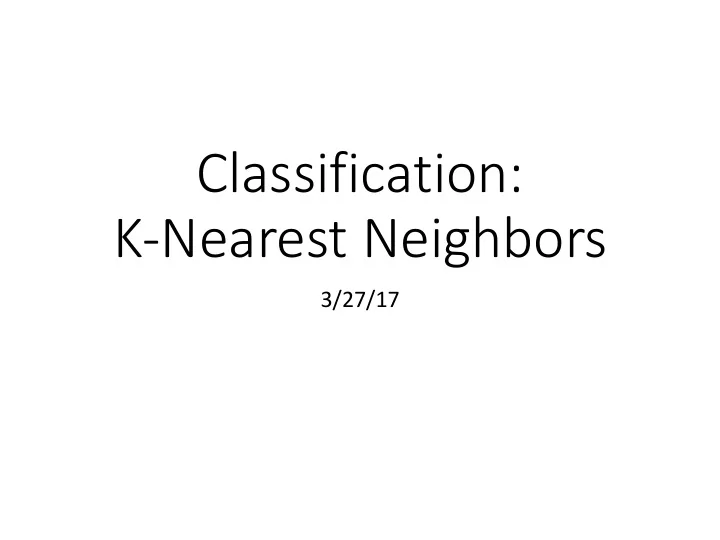

Classification: K-Nearest Neighbors 3/27/17
Recall: Machine Learning Taxonomy Supervised Learning • For each input, we know the right output. • Regression • Outputs are continuous. • Classification • Outputs come from a (relatively small) discrete set. Unsupervised Learning • We just have a bunch of inputs. Semi-Supervised Learning • We have inputs, and occasional feedback.
Classification Examples Labeling the city an apartment is in. Labeling hand-written digits.
Hypothesis Space for Classification • The hypothesis space is the types of functions we can learn. • This is partly defined by the problem, and partly by the learning algorithm. • In classification we have: • Continuous inputs • Discrete output labels • The algorithm will constrain the possible functions from input to output. • Perceptrons learn linear decision boundaries.
K-nearest neighbors algorithm Training: • Store all of the test points and their labels. • Can use a data structure like a kd-tree that speeds up localized lookup. Prediction: • Find the k training inputs closest to the test input. • Output the most common label among them.
KNN implementation decisions (and possible answers) • How should we measure distance? • (Euclidean distance between input vectors.) • What if there’s a tie for the nearest points? • (Include all points that are tied.) • What if there’s a tie for the most-common label? • (Remove the most-distant point until a plurality is achieved.) • What if there’s a tie for both? • (We need some arbitrary tie-breaking rule.)
Weighted nearest neighbors • Idea: closer points should matter more. • Solution: weight the vote by • Instead of contributing one vote for its label, each neighbor contributes votes for its label.
Why do we even need k neighbors? Idea: if we’re weighting by distance, we can give all training points a vote. • Points that are far away will just have really small weight. Why might this be a bad idea? • Slow: we have to sum over every point in the training set. • If we’re using a kd-tree, we can get the neighbors quickly and sum over a small set.
The same ideas can apply to regression. • K-nearest neighbors setting: • Supervised learning (we know the correct output for each test point). • Classification (small number of discrete labels). vs. • Locally-weighted regression setting: • Supervised learning (we know the correct output for each test point). • Regression (outputs are continuous).
Locally-Weighted Average • Instead of taking a majority vote, average the y-values. • We could average over the k nearest neighbors. • We could weight the average by distance. • Better yet, do both.
Locally-weighted (linear) regression Least squares linear regression solves the following problem: • Select weights weights w 0 , …, w D for each dimension to minimize squared error: Instead, we can minimize the distance-weighted squared error:
Decision Trees • Solve classification problems by repeatedly splitting the space of possible inputs; store splits in a tree. • To classify a new input, compare it to successive splits until a leaf (with a label) is reached. Who plays tennis when it’s raining but not when it’s humid?
Building a Decision Tree Greedy algorithm: 1. Within a region, pick the best: • feature to split on elevation • value at which to split it 2. Sort the training data into the sub-regions. 3. Recursively build decision $ / sq. ft. trees for the sub-regions. Does this give us an optimal decision tree?
Compare the Hypothesis Spaces • K-nearest neighbors Considerations: • Inputs • Outputs • Possible mappings • Decision trees • Locally-weighted regression
Recommend
More recommend